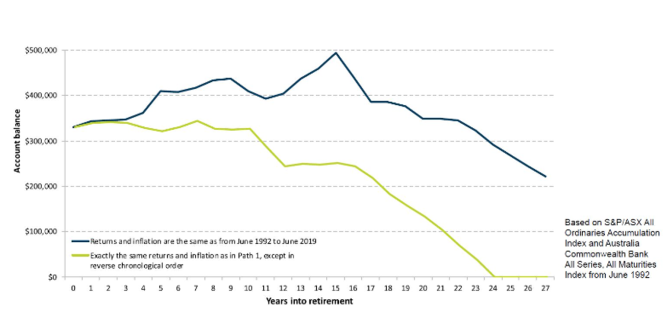Ask the Expert: Understanding sequencing risk – and how to minimise it


Question 1
- In the past you have explained how it is important in the contributing phase not to overreact during a downturn by switching to a cash position (thereby missing out on a rebound in the sharemarket). How about during the drawing-down phase, when a sharp correction in the market cannot be ameliorated by additional contributions or the luxury of time and could result in a substantial dent in a person’s balance with no ability to recover?
This is a very good question, not an easy one, but a good one none the less. I’ll have a go at it …
Technically it’s called ‘sequencing risk’.
Sequencing risk is the risk that the order and timing of your returns in retirement are negative, resulting in less money for your retirement.
When you retire, the balance of your super fund is probably the highest it’s ever been, making the returns that much more important (positive or negative). And just after retiring you probably want or need to start drawing down on your super.
If you are then unlucky, you will start getting negative returns on a large balance at the same time as drawing down from your super thereby locking in (or crystallising) those negative returns as the money you have spent obviously won’t be invested and have time to recover.
Another way of looking at it is you may get an average long-term return of about 8 per cent in retirement.
But if you have some really bad years early on, the money will run out a lot faster than if you got those bad years towards the end your retirement.
There have been many studies on this and it’s technically referred to money-weighted return, where two people may get the same long-term return but their results could be vastly different depending on in which order they experienced those returns.
Challenger provides the below example:
The investor illustrated in the chart below retired at the end of 1992 with an investment balance of $350,000. Their portfolio was 50 per cent invested in Australian shares and 50 per cent in Australian bonds. Following their retirement, they lived off the retirement savings, drawing $22,530, indexed to inflation, each year.
Both the blue and green line have the same returns, just in reverse order. As you can see the portfolio in green suffers badly.
So how to deal with sequencing risk? Let’s briefly look at a few options:
Safe withdrawal rates
The idea here is if you only draw down or spend 4 per cent of your balance each year, you won’t run out of money even if you do have some bad returns in the first few years.
The downside to this approach is that nearly everyone, by definition, spends way less than what they could have and ends up dying with most of their money not spent.
The other downside is that your income could vary significantly, for example if drawing 4 per cent of $500,000 your income is $20,000. But if your portfolio drops to $400,000 your income is now only $16,000.
The bucket approach
The bucket strategy is to draw down from a bucket of money that is not affected by market volatility.
For example, you might put a couple of years of drawdown in cash. This provides time for growth investments in other bucket(s) to recover from market downturns.
This strategy is popular with some financial advisers, but I’m not a fan.
At some stage, the buckets need to be refilled and it involves trying to time the market, which no adviser can do reliably.
Psychologically it can have some benefits as you don’t panic when markets are going backwards, but mathematically it makes no difference.
Go defensive
Having most of your super in defensive assets like cash and fixed interest can avoid big negative returns and hence sequencing risk. However, over the long term you will achieve a lower rate of return.
Ideally you should be investing consistent with your risk profile.
Other assets and lifetime annuities
Most retirees put all their super into an account-based pension, which can be subject to investment volatility and sequencing risk.
Consider having money outside of this portfolio so you can reduce drawdowns in bad years.
Further to this you may also want to consider a lifetime annuity, for part of your portfolio, that is not subject to markets, and as the name suggests lasts your lifetime.
In retirement I like to target your desired income first as that’s what will lead to you meeting your goals. No matter if your actual super balance goes up and down.
Financial advisers have sophisticated software that can run all sorts of scenarios to provide you with some comfort.
You may want to speak to an adviser of your super fund for advice.
Question 2
- A friend died last year. Part of his super was an accumulation account which had to be paid out on his death to his widow. Is there any way this could have been preserved in superannuation – for example by setting up a self-managed fund by combining accumulation funds from both parties?
Sorry to hear about your friend.
Most super funds these days offer the option for the living spouse to either have the funds cashed out, or for the funds to be converted to a superannuation income stream so they can continue to be held within the superannuation system.
They cannot, however, be held within accumulation, nor mixed with the surviving spouses super. They must remain separate.
As I said most super funds allow this, depending on their trust deed, but you would need to check with the actual fund.
Craig Sankey is a licensed financial adviser and head of Technical Services & Advice Enablement at Industry Fund Services
Disclaimer: The responses provided are general in nature, and while they are prompted by the questions asked, they have been prepared without taking into consideration all your objectives, financial situation or needs.
Before relying on any of the information, please ensure that you consider the appropriateness of the information for your objectives, financial situation or needs. To the extent that it is permitted by law, no responsibility for errors or omissions is accepted by IFS and its representatives.
The New Daily is owned by Industry Super Holdings








